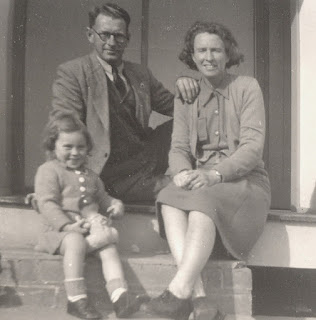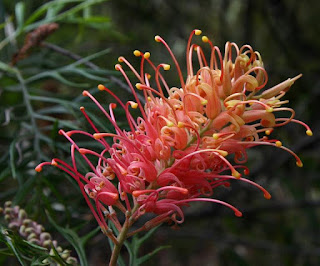 |
| Reed family, about 1891 |
The Reed sisters
My paternal grandmother, Granny Tucker was one of six daughters of Robert Henry Reed (1858-1915) who was born in Plymouth, Devon but grew up in Southampton where he moved with his mother and siblings in the 1860s. After marrying Harriett Rose (1859-1924), he became an ambitious master baker with three bakeries and a tearoom. The family, although large like many Victorian families, was quite comfortable in the 1880s, 90s and pre-WW1.
The six girls had an older brother - George Henry Reed - born in 1877. The photo on the left includes my only photo of him. He was learning the bakery trade but married and moved to Canada in 1913. It is unknown whether he ever visited England again.
The first girl, Harriett Sophia Reed was born very soon after her brother but she died within a few months. Her middle name was that of her eldest aunt and she was named for her mother and grandmother, both called Harriett.
 |
| Harriet Reed Yeoman's house in Southampton |
Harriett Peirce Reed, the oldest surviving sister was born in 1878, again named after her mother, Harriet Rose Reed. She became a schoolteacher in Southampton and did not marry until 1932. Her husband, a widower was a master grocer. Harriet survived him by a number of years, dying in 1953. In about 1960, my father received a solicitor's letter stating she had left most of her property to him and his surviving sister Cecily Mary Tucker in Australia. Again, I have no other photo of Harriet. Her middle name was her maternal grandmother's surname although it is usually spelt Pearse. She is the girl sitting with the stick on her lap.
 |
| Alice Reed Bayford & son Norman |
The second daughter Alice Rose Reed was born in 1881. Alice is standing beside her father in the photo above. She married her first cousin James Bayford in 1910 and moved to Hammersmith in London. James was the son of Sophia Pearse Reed, Robert Henry Reed's older sister. She had one son, Norman Bayford.
Unfortunately, her husband James Bayford died of malaria whilst serving in Thessalonika in Greece in 1918. He was an insurance agent before the war and Alice continued to run the business until her retirement, possibly in the 1940s. She appeared to be a very practical woman and was the executor of her mother's will in 1924. Additionally, she assisted her mother and two of her sisters trading out of debt left behind after their father's demise in 1915.
 |
| Minnie Reed Irvine/Young on right |
 |
| Edith Reed Tucker & son Bob |
My grandmother Edith Annie (1884-1973) was the fourth surviving daughter. She was musical and started courting my grandfather Sydney George Tucker, the son of a prosperous music dealer aged sixteen. They were engaged when she was 21 and married at 23 at Bovey Tracy in Devon. Her uncle gave her away. This appears strange. Did her father not approve of her marriage? Whatever the reason, they were very happily married, with daughters Jessie Agnes and Cecily Mary born in 1908 and 1910, followed by my father (pictured) in 1914. Syd signed up as an aircraft gunner but suffered serious wounds, both physical and mental and died of his own hand in 1919, whilst in hospital. My grandmother had a tough life thereafter since her father was deceased and her father-in-law had remarried a much younger woman who convinced him to change his will. My grandmother was forced to send her daughters to Dr Barnardo's Homes whilst she worked in the confectioners' tearooms.
 |
| Tucker family in April 1917 |
In 1923, Dr Barnardo's Homes proposed sending one of the sisters to Canada and one to Australia, both as domestic servants. The girls, just 13 and 15 insisted on going together and their mother supported them to do so if they were happy to. In January 1924 they were sent to Sydney, NSW and their mother and brother were facilitated by Barnardos to join them in 1925. Whilst the children were happy, Edith never felt settled, had to take up domestic work to survive but never saw England again. She remained a widow with my father supporting her by purchasing a house from his war savings. She died in 1973, having spent long stretches dealing with and being treated for depression.
Kate Rose Reed was born on Christmas Day, 1885. She married Sidney Bellenger, a printer with whom she worked in 1909. The couple had no children but together with her oldest sister, teacher Harriett supported Edith's children in practical ways such as warm clothing and shoes after Edith became widowed. My dad and other family members called the couple Steak and Kidney, behind their backs presumably. Kate often wrote to her sister Edith and to my parents in Australia. She died in 1971.
A son was born in 1887 and named after his father, but died within 12 months.
 |
| Molly and Jean Kennedy before parting in 1927 |
The youngest daughter, Jessie was born on 24th June 1989. She married a professional cricketer, Alexander Stuart Kennedy in April 1910 and their older daughter Mary (Molly) Stuart Kennedy was born later that year. I was told that Jessie perfected her cake decorating skills whilst working with her mother and sisters post-WW1. Alex represented England in five test matches against South Africa and in the early 20s, the family migrated to Cape Town, South Africa where Alex became a cricket coach. Another daughter Jean was born in 1923 but the marriage was already in jeopardy.
 |
| Jessie Reed Kennedy/Davies |
Alex initiated divorce proceedings on the grounds of adultery, finalising the case in 1925 and by 1927, Molly Kennedy accompanied her father back to England, leaving baby Jean with her mother. Jessie then married Charles Davies in Cape Town and had three more children by him. The family later migrated to Rhodesia where Jessie died of cancer in 1957.
Jessie and my grandmother Edith corresponded for the rest of their lives. My father remembers meeting the family with his mother in Cape Town in 1925 on his way to Australia.
Descendants of the four sisters who had children are now scattered over four continents: England, Australia (including some from South Africa and Zimbabwe), South Africa and America (Florida). Since 2008, I have met three out of four cousins in England, seven in Florida and two in Australia (both born in Africa).
My father particularly remembers being surrounded by kindly aunts in England and later receiving care packages and letters from them during his WW2 service in New Guinea and Bougainville.




